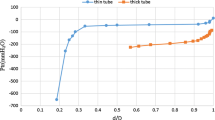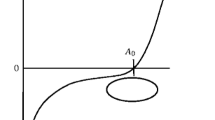Abstract
A transmission testing technique has recently been developed whereby some of the characteristics of a liquid-filled tube, as used in electromanometry, can be measured at sub-audio and audio frequencies, using apparatus readily available in teaching hospitals. Pressure ratios and phase readings are obtained from Lissajous figures displayed on an oscilloscope. The attenuation and phase constants of the tube are determined by simple calculations from these readings. The transfer loss and phase shift of the output transducer and its associated hardware can sometimes be measuredin situ as part of the same test. Using additional data derived from static measurements and formulae well-known in electrical theory, it is possible to deduce practically all the information required for engineering purposes, including an approximate analysis of the various losses of the tube and the determination of the characteristic impedance as a complex function of frequency.
Tests of this kind have given fairly reliable and repeatable results up to 300 c/s, although a few minor phenomena still require investigation. No insurmountable difficulty is foreseen in extending the tests to 1000 c/s or beyond. (The determination of phase shift up to 700 c/s has been demonstrated at a recent conference).
Although the original object of the experiment was merely to measure the properties of a liquid-filled tube, considered as a hydraulic component of a system, some facts of wider significance were also observed. Preliminary experiments indicate that the gap between the frequency range of the electromanometer and that of the stethoscope can be bridged. Experimental verification of transmission line theory, as applied to liquid-filled tubes, has been obtained, thus incidentally supporting a conjecture of Noble and Barnett, which was regarded as unjustified by Vierhout. Partial experimental proof that the Womersley solution of the Navier-Stokes equation can be applied to non-rigid tubes, also a matter of some argument, has already been obtained, and there now appears to be no major obstacle to prevent a final clarification of this question.
It is now possible to deduce the elastic behaviour and the mechanical hysteresis loss of plastic materials as a function of frequency over the range 0–300 c/s and beyond, which means that the method may prove a useful tool for research into the physical properties of plastics. Adaptations of the same test rig may also find applications in the routine maintenance of hospital apparatus and in haemodynamics.
Sommaire
On a mis récemment au point une technique permettant de mesurer aux fréquences audibles et sub-audibles quelques-unes des caractéristiques de transmission d'un tube rempli de liquide (comme ceux qu'on emploie en électromanométrie), avec l'aide d'un appareillage disponible dans les hôpitaux universitaires. Les rapports de pression et les mesures de phase sont obtenus à partir des courbes de Lissajous présentées sur un oscilloscope. Les constantes d'affaiblissement et de phase du tube sont déterminés par simple calcul à partir de ces mesures. Les pertes de transfert et le déphasage introduits par le capteur à la sortie du tube, et le matériel qui l'entoure peuvent parfois être mesurésin situ dans les mêmes conditions. A l'aide de données supplémentaires obtenues par des mesures statiques et des formules bien connues en électricité, on peut pratiquement déduire toutes les informations nécessaires concernant l'utilisation du tube. En particulier, on peut connaître approximativement les diverses pertes du tube et déterminer son impédance caractéristique, exprimée comme une fonction complexe de la fréquence.
Des measures de ce genre ont donné des résultats assez sûrs et reproductibles jusqu'à 300 c/s, bien que certains phénomènes mineurs demandent encore à être étudiés. On ne prévoit aucune difficulté insurmontable à prolonger ces mesures jusqu'à 1000 c/s et au-delà (on a démontré lors d'une récente conférence que l'on peut déterminer l'écart de phase jusqu'à 700 c/s). Bien que le but initial de l'expérience ait été de mesurer uniquement les proprietés d'un tube rempli de liquide, considéré comme un composant hydraulique d'un système, on a observé quelques faits de plus grande importance. Des expériences préliminaires prouvent qu'on peut combler l'écart entre la bande de fréquence de l'électromanomètre et celle du stéthoscope. On a obtenu une vérification expérimentale de la théorie de lignes de transmission appliquées aux tubes remplis de liquide, justifiant ainsi l'hypothèse de Noble et Barnett, qui était considérée par Vierhout comme étant sans preuve suffisante. On a déjà obtenu en partie la preuve expérimentale que la solution de Womersley de l'équation de Navier-Stokes peut être appliquée à des tubes nonrigides, ce qui est aussi un argument important. Il semble donc qu'il n'y ait plus aucun obstacle majeur à la clarification totale de cette question.
Il est possible maintenant de déduire le comportement élastique et les pertes d'hystérèsis mécaniques des matériaux plastiques en fonction de la fréquence, dans la bande 0–300 c/s et au-delà: la méthode pourra ainsi être un outil utile dans la recherche des proprietés physiques des plastiques.
Adapté, ce même équipement de mesure peut également trouver des applications dans la maintenance systèmatique des appareillages hospitaliers ainsi qu'en hémodynamique.
Zusammenfassung
Kürzlich wurde eine neue Methode der Übertragungsmessung entwickelt, dabei können Einige der Eigenschaften der flüssigkeitsgefüllten Schläuche, wie sie in der Elektromanometrie verwendet werden, bei Subaudio-und Audiofrequenzen mit Geräten gemessen werden, welche in Lehrhospitälern vorhanden sind. Die Druck- und Phasenverhältnisse können von Lissajouschen Figuren abgelesen werden, die an einem Oszillographen abgebildet werden. Die Dämpfungs- und Phasenkonstanten des Schlauches ergeben sich durch einfache Rechnung von diesen Ablesungen. Als Teil dieses Tests kann manchmal gleichzeitigin situ der Übertragungsverlust und die Phasenverschiebung des Ausgangstransducers und seiner angeschlossenen Röhren und andere Bestandteile bestimmt werden. Unter Verwendung zusätzlicher Daten von statischen Messungen und bekannten Formeln aus der Elektrotheorie kann man praktisch die gesamte für die Konstruktion nötige Information erlangen. In diesen Befunden sind die Näherungsanalyse der verschiedenen Verluste des Schlauches und die Bestimmung der charakteristischen Impedanz als komplexe Funktion der Frequenz einbegriffen.
Untersuchungen dieser Art ergaben ziemlich verläßliche und übereinstimmende Resultate bis zu 300 c/s. Einige weniger bedeutsame Phänomene müssen allerdings noch untersucht werden. Der Erweiterung des Tests bis 1000 c/s oder mehr scheinen keine unüberwindlichen Schwierigkeiten entgegenzustehen. (Auf einer kürzlichen Konferenz wurde die Bestimmung der Phasenverschiebung bis zu 700 c/s demonstriert).
Obwohl ursprünglich nur die Eigenschaften eines flüssigkeitsgefüllten Schlauches gemessen werden sollten, der als hydraulische Komponente des Systems betrachtet wurde, traten auch einige Gegebenheiten von weitreichender Bedeutungzutage. Vorversuche deuten an, daß die Lücke zwischen dem Frequenzbereich des Elektromanometers und dem des Stethoskops geschlossen werden kann. Die Übertragungs-Linien-Theorie wurde in der Anwendung auf flüssigkeitsgefüllte Schläuche experimentell bestätigt, eine Unterstützung der Hypothese von Noble und Barnett, welche von Vierhout als unberechtigt abgelehnt worden war. Ein teilweiser experimenteller Nachweis, daß die Womersley-Lösung der Navier-Stokes-Gleichung auf nichtfeste Röhren angewandt werden kann (eine ebenfalls umstrittene Frage) wurde schon geführt. Für die endgültige Klärung dieser Frage scheinen jetzt keine Hindernisse mehr zu bestehen.
Man kann jetzt das elastische Verhalten und die mechanischen Hystereseverluste von plastischen Materialien als Funktion der Frequenz im Bereich zwischen O und 300 c/s und mehr bestimmen. Die Methode kann sich also für die Untersuchung der physikalischen Eigenschaften von Plastikstoffen als geeignet erweisen. Änderungen der Versuchsanordnung können auch zu Verwendungsmöglichkeiten in der Routineüberwachung von Krankenhausgeräten und in der Hämodynamik führen.
Similar content being viewed by others
References
Crul, J. F. (1962) Measurement of arterial pressure,Acta anaesth. scand. 6, Suppl. 11, 135–169.
Frank, O. (1903) Kritik der elastischen Manometer,Z. Biol. 44, 445–613.
Gabe, I. T. (1965) Arterial blood flow by analogue solution of the Navier-Stokes equation,Phys. Med. Biol. 10, 271–280.
Hansen, A. T. (1949) Pressure measurements in the human organism,Acta physiol. scand. 19, Suppl. 68, 7–230.
Lamb, H. (1963)Hydrodynamics, pp.xv and 738, Cambridge University Press. Many earlier editions.
Latimer, K. E. (1968) The transmission of sound waves in liquid-filled catheter tubes used for intravascular blood-pressure recording,Med. biol. Engng 6, 29–42.
McDonald, D. A. andTaylor, M. G. (1959) The hydrodynamics of the arterial circulation,Prog. Biophys. biophys. Chem. 9, 105.
Noble, F. W. andBarnett, G. O. (1963) An electric circuit for improving the dynamic response of the conventional cardiac catheter system,Med. Electron. biol. Engng. 1, 537–545.
Olson, H. F. andMassa, F. (1939)Applied Acoustics, pp. xviii and 494, Constable, London.
Vierhout, R.R. (1966) The response of catheter manometer systems used for direct blood pressure measurements, Thesis, Catholic Univ. of Nijmegen, p. 109 (English) and Stellingen 1–13 (Dutch).
Womersley, J. R. (1955) Method for the calculation of velocity ratio, rate of flow and viscous drag in arteries when the pressure gradient is known,J. Physiol., Lond. 127, 553–563.
Womersley, J.R. (1957) An elastic tube theory of pulse transmission and oscillatory flow in mammalian arteries, W.A.D.C. Tech. Rept., TR 56-614, Jan., Min. of Tech. accession No. P 67984, p. 115 and Al-123.
Basic principles, chronological order
Newton, I. (1687)Philosophiae naturalis principia mathematica. Book II, Proposition 48 and 50, and scholion. Sound velocity formula, equivalent to 1/√(ρK) whereK is theisothermal compressibility.
Laplace, P. S. (1816)Annls Chim. Phys. (2)3, 238–241. Found thatK should be theadiabatic compressibility.
Savart, F. (1825)Annls. Chim. Phys. (2),30, 64–87. Found thatK should include the compressibility due to the tube wall.
Haemodynamics, chronological order
Young, T. (1808) On the propagation of an impulse through an elastic tube (Hydraulic investigations, No. 3).Phil. Trans. Part I, 164. A badly presented, misleading paper, which exicted little interest. He was aware, however, that pulses are propagated along arteries.
Ferner (1827) De utilitate parietis elastici arteriarum, 20 Nov. 1827, Leipzig, summarized inAnnotat.Anatomicae Physiologicae Leipzig4, 1–12 (1834). Inaccessible but reported byWeber (1850). States clearly that arterial pulses are propagated with finite velocity. This started a controversy, which was not settled until 1850.
Weber, E. H. (1850)Weber W. (1866), Über die Anwendung der Wellenlehre auf die Lehre vom Kreislaufe des Blutes und inbesondere auf die Pulslehre. Berichte über die Verhandl., Kön. Sächs Gesell. der Wissen., Leipzig, Math. -Phys. Cl., Pt. I, 164–204, (1850). Part was omitted by printers and published ibid., (1866), Pt. IV–V, 353–357 under name ofW. Weber and title Theorie der durch Wasser oder andere incompressibele Flüssigkeiten in elastischen Röhren fortgepflanzten Wellen. See also Ostwald's,Klassiker der exacten Wissenschaften, No. 6, Leipzig, pul. Engelmann 1889, Edited byvon Frey. E. H. Weber initiated wave-propagation experiments on a simulated artery. Reported byTigerstedt (1893) andLambossy (1950).
Resal, H. (1876) Note sur les petits mouvements d'un fluide incompressible dans un tuyau élastique.J. Math. pures appl., 3rd. Ser.,2, 342–344, Paris, Short, competent mathematical treatment.
Moens, A. Isebree (1878)Die Pulskurve, 145 pp. E.J. Brill,Leiden, Only copy at R. Coll. Phys., Edinburgh. See p. 87et seq. Enlarged version of thesis, aided by correspondence withKorteweg (1878).
Korteweg, D. J. (1878) Über die Fortpflanzungsgeschwindigkeit des Schalles in elastischen Röhren,Ann. Phys. Chem. New series,5, 525–542. Abridged version of thesis. SeeMoens above.
Tigerstedt, R. (A.A.) (1893)Lehrbuch der Physiologie des Kreislaufes, 364–377. Von Veit, Leipzig.
Witzig, K. (1914) Über erzwungene Wellenbewegungen zäher, inkompressibler Flüssigkeiten in elastischen Röhren, Inaug. Diss., Berne. p. 50. Missing in U.K.
Lambossy, P. (1950, 51) Aperçu historique et critique sur le problème de la propagation des ondes dans un liquide compressible enfermé dans un tube élastique.Helv. physiol. pharmac. Acta. 8, 209–227 (1950) and 9, 145–161 (1951). Good paper, extensive bibliography.
Lambossy, P. (1952). Oscillations forcées d'un liquide incompressible et visquex dans un tube rigide et horizontal. Calcul de la force de frottement.Helv. Phys. Acta 25, 371–386.
Müller, A. (1950) Über die Fortpflanzungsgeschwindigkeit von Druckwellen in dehnbaren Röhren bei ruhender und strömender Flüssigkeit.Helv. physiol. pharmac. Acta 8, 228–241.
Müller, A. (1951) Über die Abhängigkeit der Fortpflanzungsgeschwindigkeit und der Dämpfung in dehnbaren Röhren von deren Wellenlänge.Helv. physiol. pharmac. Acta 9, 162–176. Müller's experiments were carried out on large thin-walled tubes by a technique somewhat resembling that described in the present article, but unsuitable for tubes with a small lumen. Lambossy and Müller both worked at the University of Fribourg in the Canton of Fribourg, Switzerland, not to be confused with the University of Freiburg im Breisgau, Germany, the source of other papers, cited by Tigerstedt, but not so relevant to the present subject.
Author information
Authors and Affiliations
Rights and permissions
About this article
Cite this article
Latimer, K.E., Latimer, R.D. Measurements of pressure-wave transmission in liquid-filled tubes used for intravascular blood-pressure recording. Med. & biol. Engng. 7, 143–168 (1969). https://doi.org/10.1007/BF02474172
Received:
Revised:
Issue Date:
DOI: https://doi.org/10.1007/BF02474172




